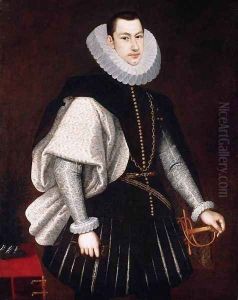Rodrigo de Villandrando Paintings
Rodrigo de Villandrando was a Spanish painter and engraver, born in 1588 in Córdoba, Spain. Although not as widely known as some of his contemporaries, Villandrando's work provides a fascinating insight into the early 17th-century Spanish art scene, particularly in the realms of portraiture and religious imagery. His life, marked by both artistic innovation and the challenges of the times he lived in, reflects the tumultuous period of Spanish history during which he worked.
Villandrando's early life is somewhat obscure, but it is believed that he received his initial training in the arts in his hometown of Córdoba. He later moved to Madrid, where he became part of the vibrant artistic community, honing his skills and establishing his reputation. Villandrando's style was deeply influenced by the Mannerist and early Baroque trends, emphasizing complex compositions, dramatic expressions, and a strong use of chiaroscuro to highlight the emotional depth of his subjects.
Throughout his career, Villandrando focused primarily on portraiture. He became renowned for his ability to capture not just the physical likeness of his subjects but also their personality and status. His portraits often depicted members of the Spanish nobility and clergy, showcasing the wealth and power of his patrons through elaborate clothing, jewelry, and settings. These works are characterized by their detailed execution and the sophisticated use of color and light, qualities that made Villandrando a sought-after portraitist of his time.
In addition to his portraiture, Villandrando also contributed to religious art, creating altarpieces and other devotional works for churches and convents. These pieces often featured scenes from the life of Christ, the Virgin Mary, and the saints, rendered with a deep sense of piety and devotion. Villandrando's religious works are noted for their emotional intensity and the skillful way in which he depicted the divine and human figures alike.
Rodrigo de Villandrando's career was cut short by his untimely death in 1622, at the age of 34. Despite his brief life, his work left a lasting mark on the Spanish art scene of the early 17th century. Today, Villandrando's paintings can be found in museums and collections in Spain and around the world, where they continue to be appreciated for their beauty and historical significance. His legacy is that of an artist who was able to capture the essence of his time through the faces of those he painted, providing a window into the soul of early modern Spain.




